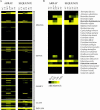Rapid quantitative profiling of complex microbial populations
- PMID: 16407321
- PMCID: PMC1326253
- DOI: 10.1093/nar/gnj007
Rapid quantitative profiling of complex microbial populations
Abstract
Diverse and complex microbial ecosystems are found in virtually every environment on earth, yet we know very little about their composition and ecology. Comprehensive identification and quantification of the constituents of these microbial communities--a 'census'--is an essential foundation for understanding their biology. To address this problem, we developed, tested and optimized a DNA oligonucleotide microarray composed of 10,462 small subunit (SSU) ribosomal DNA (rDNA) probes (7167 unique sequences) selected to provide quantitative information on the taxonomic composition of diverse microbial populations. Using our optimized experimental approach, this microarray enabled detection and quantification of individual bacterial species present at fractional abundances of <0.1% in complex synthetic mixtures. The estimates of bacterial species abundance obtained using this microarray are similar to those obtained by phylogenetic analysis of SSU rDNA sequences from the same samples--the current 'gold standard' method for profiling microbial communities. Furthermore, probes designed to represent higher order taxonomic groups of bacterial species reliably detected microbes for which there were no species-specific probes. This simple, rapid microarray procedure can be used to explore and systematically characterize complex microbial communities, such as those found within the human body.
Figures






References
-
- Savage D.C. Microbial ecology of the gastrointestinal tract. Annu. Rev. Microbiol. 1977;31:107–133. - PubMed
-
- Rakoff-Nahoum S., Paglino J., Eslami-Varzaneh F., Edberg S., Medzhitov R. Recognition of commensal microflora by toll-like receptors is required for intestinal homeostasis. Cell. 2004;118:229–241. - PubMed
-
- Hooper L.V., Wong M.H., Thelin A., Hansson L., Falk P.G., Gordon J.I. Molecular analysis of commensal host-microbial relationships in the intestine. Science. 2001;291:881–884. - PubMed

